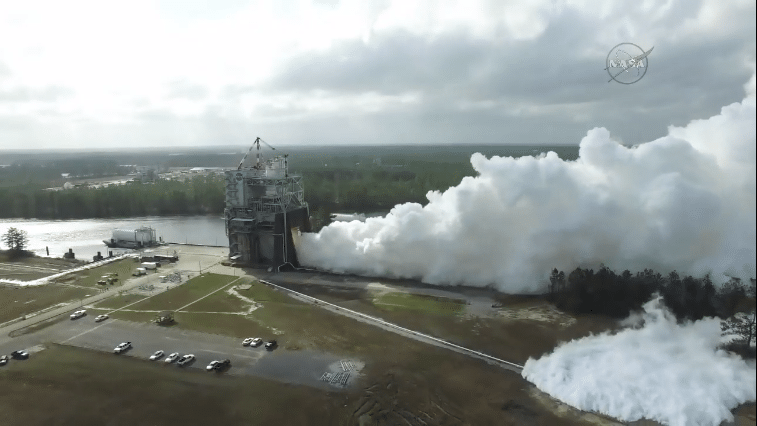Latest News

Screen grab from NASA TV during the RS-25 test fire live streaming. Photo: NASA TV
With an eye toward future deep space missions, Aerojet Rocketdyne and NASA powered up the RS-25 main engine for the agency’s heavy-lift Space Launch System (SLS) to its highest thrust levels yet. During a 260-second hot fire test on Feb. 21, the RS-25 engine throttled up to 113 percent of its original design thrust level. The first four flights of SLS will use engines that max out at 109 percent of rated thrust (these same engines operated at 104.5 percent rated thrust when flown on the Space Shuttle). New RS-25 engines developed under Aerojet Rocketdyne’s restart program will baseline their thrust at 111 percent.
The RS-25 is an updated version of the Space Shuttle Main Engine that helped power the Space Shuttle into space. There are 16 flight engines that will power the first four SLS flights in inventory at Aerojet Rocketdyne’s Stennis facility. Fourteen of the engines previously flew aboard the Space Shuttle. The SLS rocket was designed for missions beyond Low Earth Orbit carrying crew or cargo to the Moon or beyond. The initial configuration for what SLS can carry past Low Earth Orbit (LEO) and on to the Moon is more than 26 metric tons, with a final configuration of at least 45 metric tons. All SLS configurations are powered by four RS-25 engines attached to the 212-foot-tall core stage, the backbone of the rocket being built at NASA’s Michoud Assembly Facility in New Orleans.
The latest RS-25 hot fire test also was the fourth involving an additively manufactured pogo accumulator assembly. The assembly is the largest 3D printed RS-25 component tested to date. Newly manufactured RS-25 engines, to be used starting with the fifth SLS mission, will incorporate the additively manufactured pogo accumulator assembly and other 3D printed parts currently in development. This effort is one of many focused on making the engine more affordable for future missions.
The first SLS mission is scheduled for 2020, when the rocket will blast off carrying an uncrewed version of NASA’s Orion spacecraft on a mission beyond the Moon farther than any human-rated space vehicle has ever traveled. The SLS-Orion combo is scheduled to fly a similar mission profile in the early 2020s, only this time with an astronaut crew on board.
Get the latest Via Satellite news!
Subscribe Now